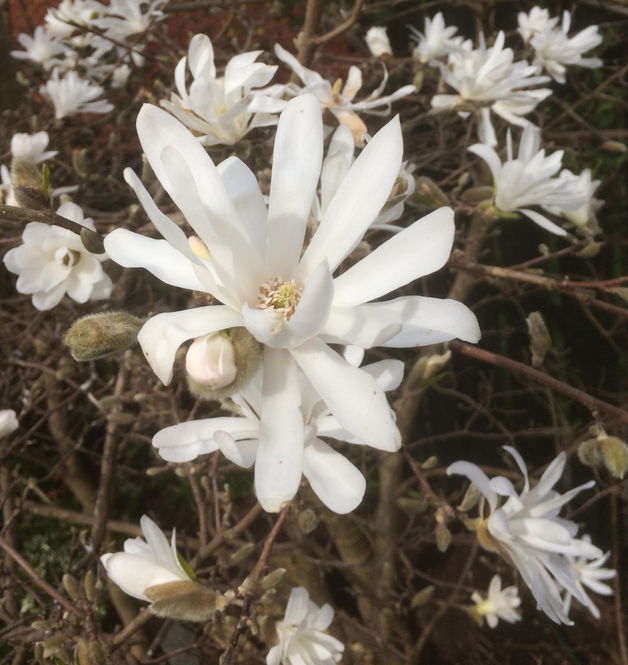Notes from the Chairman's Garden: Magnolia stellata

by David Mitchell
Magnolia stellata, or Star Magnolia, originates from Japan; closely related to Magnolia kobus, it occurs naturally between an altitude of 50m and 600m in temperate broadleaf forests where it is often found by streamsides or the margins of small ponds and lakes. Two publications Hortus Veitchii (Veitch. J. H. 1906) and Curtis Botanical Magazine (B.M. 6370) credit Richard Oldham (1838-1864) with its introduction from the gardens of Nagasaki to Great Britain in 1862. Jim Gardener notes in Magnolias A Gardiners Guide (2000) that it was introduced to the west a year earlier by one George Hall presented material for propagation to the New York Nurserymen Parsons Brothers in 1861. The generic name Magnolia is after the French Botanist Pierre Magnol (1638-1715) and the specific epithet stellata refers to starry shaped flowers.
It is definitely one of my favourite early deciduous flowering shrubs; generally hardy throughout most of Scotland it is great choice beginner or expert if you want a magnolia for your garden. It enjoys lots of sunshine and shelter from the wind and late frosts; thriving in acid soils it is also a good idea to add lots garden compost or leaf-mould at the time of planting. It will also thank you for a good mulch of the same now and again over the years, especially in a dry summer when it should be put on after rain to trap the moisture.
As it can grow in time becoming up to 3m in height and 4m in breadth you could say it is a small tree perhaps; however slow rate of growth and compact habit make it one of the most desirable of all magnolias and an ideal subject for the town garden. It is however equally happy in the woodland or with mixed plantings in a walled garden.
I always suggest placing it so that in time it will reach out towards the front of the border where you can enjoy the abundance of flowers close up admiring their beauty, complex structure and texture as well as the delicate light fragrance that to me is reminiscent of a combination of lemon and butterscotch!
The open habit of the branches means that it can be easily under planted with early spring bulbs such as small narcissus or grape hyacinths for a fine display. If you like you can also seek out the lovely cultivar ‘Water Lily’ which has larger flowers and a pink flush prior to fully opening.
The genus Magnolia is an ancient genera of angiosperms and one of the first flowering plants to have evolved to become insect pollinated; mainly by beetles. The fossil evidence to date places them some time after the Mid Cretaceous 80.0 to 85.00 Ma, primarily during the Paleocene to the Pliocene 66.0 to 2.58 Ma. Their often-colourful bright red seeds are eaten and distributed in the wild by birds and small animals.
In the Victorian Language of Flowers magnolias symbolised dignity and nobility. In ancient China, magnolias were thought to be the perfect symbols of womanly beauty and gentleness.
Did you enjoy this article? Check out Wild Garlic, Pecan and Manchego Pesto Recipe


